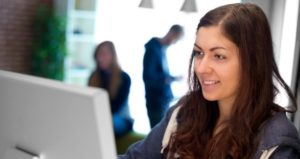
Strategic Blended Learning in Higher Education
In spring 2021, inspired by feedback from students, I redesigned my two undergraduate education courses as blended learning courses. While I was familiar with the


In spring 2021, inspired by feedback from students, I redesigned my two undergraduate education courses as blended learning courses. While I was familiar with the

The challenges for faculty working with students in the 21st century are rising. How can faculty meet the many challenges facing higher education? In the

In higher education, the need for blended learning strategies will continue to grow. This resource guide will help you facilitate a fast change to engaging

As society has evolved, so too has education. To meet the changing needs of our world, an explosion of online education has focused on adult

“There’s just not enough time in class with students!” It’s a common faculty complaint, and when students are provided quality course materials they can use outside class, this blended learning approach gives faculty more time in class. A variety of materials can be developed for use outside class. In this article, we’d like to focus on creating video content that students use for a blended learning course.
Professor Philip LaRocco is reimagining his Energy Business and Economic Development course with digitized lecture materials, collaborative assignments, and real-time feedback. With funding from Columbia University’s Office of the Provost, LaRocco teamed up with the Columbia Center for New Media Teaching and Learning (CCNMTL) to build a learning environment more conducive to the world in which his students currently intern, and plan to work in post-graduation. He is following a “flipped classroom” model—filming some of his lectures and making them available to students prior to class meetings—making way for more elaborate group review, discussions, and other collaborative assignments during class.
Blended learning has gone from being an interesting new hybrid of traditional and online courses to being an expected part of American education. When the Sloan Consortium last studied blended learning in 2007, it found “a lot of room for growth” in the market for blended courses. It found “consumer preference for online and blended delivery far exceeds reported experience,” indicating that demand was ahead of supply at that point.
A few weeks ago, a colleague emailed me about some trouble she was having with her first attempt at blended instruction. She had created some videos to pre-teach a concept, incorporated some active learning strategies into her face-to-face class to build on the video, and assigned an online quiz so she could assess what the students had learned. After grading the quizzes, however, she found that many of the students struggled with the concept. “Maybe,” she wondered, “blended instruction won’t work with my content area.”
Featuring six articles dedicated to blended learning and six articles on the flipped classroom, this free report provides an inside look at how faculty are using these approaches to reshape the college classroom.
Blended learning entails more than simply replacing class time with online course elements or supplementing an online course with face-to-face meetings. To be successful, the online and face-to-face modes need to be integrated by taking into account the learning objectives and the affordances of each mode and deliberately linking what occurs in each mode.
Get exclusive access to programs, reports, podcast episodes, articles, and more!